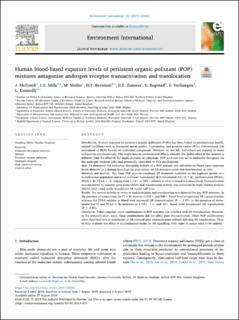| dc.description.abstract | Introduction Human exposure to persistent organic pollutants (POPs) has been linked to genitourinary health-related conditions such as decreased sperm quality, hypospadias, and prostate cancer (PCa). Conventional risk assessment of POPs focuses on individual compounds. However, in real life, individuals are exposed to many compounds simultaneously. This might lead to combinatorial effects whereby the global effect of the mixture is different from the effect of the single elements or subgroups. POP mixtures may act as endocrine disruptors via the androgen receptor (AR) and potentially contribute to PCa development. Aim To determine the endocrine disrupting activity of a POP mixture and sub-mixtures based upon exposure levels detected in a human Scandinavian population, on AR transactivation and translocation in vitro. Materials and methods The Total POP mixture combined 29 chemicals modelled on the exposure profile of a Scandinavian population and 6 sub-mixtures: brominated (Br), chlorinated (Cl), Cl + Br, perfluorinated (PFAA), PFAA + Br, PFAA + Cl, ranging from 1/10× to 500× relative to what is found in human blood. Transactivation was measured by reporter gene assay (RGA) and translocation activity was measured by high content analysis (HCA), each using stably transfected AR model cell lines. Results No agonist activity in terms of transactivation and translocation was detected for any POP mixtures. In the presence of testosterone the Cl + Br mixture at 100× and 500× blood level antagonised AR transactivation, whereas the PFAA mixture at blood level increased AR transactivation (P < 0.05). In the presence of testosterone the Cl and PFAA + Br mixtures at 1/10×, 1×, and 50× blood level antagonised AR translocation (P < 0.05). Conclusion Taken together, some combinations of POP mixtures can interfere with AR translocation. However, in the transactivation assay, these combinations did not affect gene transactivation. Other POP combinations were identified here as modulators of AR-induced gene transactivation without affecting AR translocation. Thus, to fully evaluate the effect of environmental toxins on AR signalling, both types of assays need to be applied. | |
